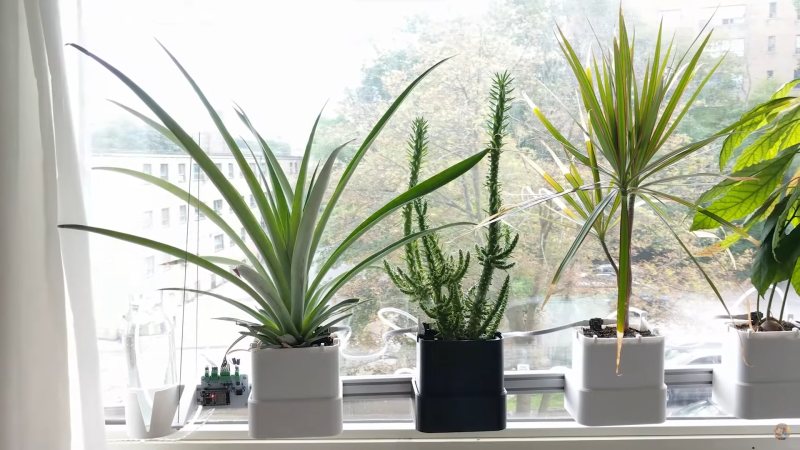The greatest threat to a potted plant stems from its owner’s forgetfulness, but [Sasa Karanovic] has created an automation system that will keep his plants from getting too thirsty. Over the past year [Sasa] has been documenting an elegant system for monitoring and watering plants which has now blossomed into a fully automated solution.
If you haven’t seen the earlier stages of the project, they’re definitely worth checking out. The short version is that [Sasa] has developed a watering system that uses I2C to communicate with soil moisture, temperature, and light sensors as well as to control solenoids that allow for individual plants to be watered as needed. An ESP32 serves as a bridge, allowing for the sensors to be read and the water to be dispensed via an HTTP interface.
In this final part, [Sasa] integrates his watering system into a home automation system. He uses a MySQL database to store logs of sensor data and watering activity, and n8n to automate measurement and watering. If something isn’t quite right, the system will even send him a Telegram notification that something is amiss.
If you think automation might be the best way to save your plants from a slow death, [Sasa] has kindly shared his excellent work on GitHub. Even if you don’t have a green thumb, this is still a great example of how to develop a home automation solution from scratch. If you’re more interested in television than gardening, check out [Sasa]’s approach to replacing a remote control with a web interface!
















Interesting. Alas, there seems to be no information about the actuator part of the system: pump and valves. Electronics is hard to design and build, but the right actuators are hard hard to find and source.
Hi Steelman. You can find links to solenoids valves, flow sensor and the pump used in this project in the part 2 video of the series. There are too many things to condense everything in one video so I broke it out into three sections. Component selection is obviously heavily biased towards my needs (or what I have available), but that shouldn’t prevent others from using whatever they want.
Also, this project is open-source open-hardware, so feel free to contribute so everyone can benefit from it.
Indeed, I missed the link. However, there is a reason I’d like to know which one precisely works for you (or at least its parameters: flow rate, output pressure, input power). I have built a watering system myself. It is not nearly as sophisticated as yours (off-the-shelf electronics: PSU for LED strips, programmale relay), but is able to support life of a few tomato plants in a planter box on my balcony during summer while I am away, so I call it success. I am not entirely happy, with how the pump works (one designed for camper and yachts, ~10 l/min, 0.5 bar, 24 W). I definitely don’t want to use it for plants in smaller pots. Because I don’t feel like having half a dozen different pumps laying around, I am asking around.
What a releaf to read a story such as this.
I see what you did there… nice! :)
Leaf your plants alone… that would have been a way better title for this video series! :)
Would seem to be an easy to implement solution for watering of individual plants.
But not something you would want to scale to several hundreds or thousands of square meters of greenhouse table space. Think decimation of sampling, and representative sampling, and area valve controllers, and pressure sensors.
Using electronic technology to address this is fun, but I’ve discovered another technology that’s simpler and more robust: terracotta water stakes fed from a central reservoir. I use the ones from Blumat. The plants are thriving and all I do is fill up the glass water tank from time to time. Win-win!
Checking that out!
Thanks!
Using electronics to monitor plants seems a bit excessive, especially when something as simple as a plug-in timer can be plenty for plant care.
Depends on what kind of plants you have. Some of them are super needy and need attention daily, others are fine as long as you give them some water once a week.